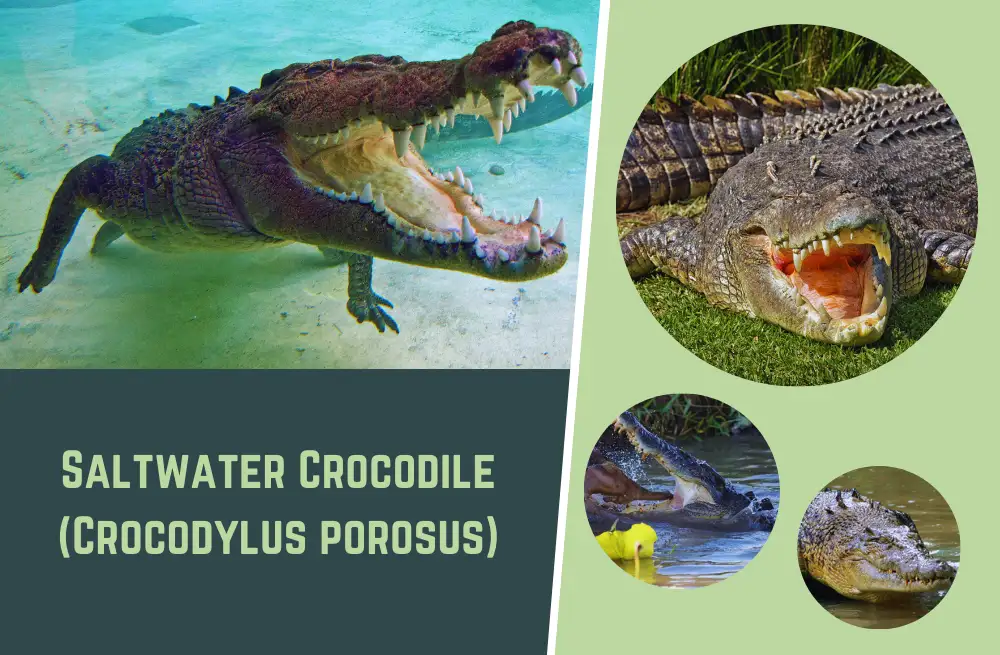Mugger Crocodile (Gavialis gangeticus): Facts, Habitat & Pictures
Mugger crocodiles, also known as marsh crocodiles or Crocodylus palustris, are one of the most formidable predators in the Indian subcontinent and Sri Lanka. They are one of three species of crocodile found in India, along with the gharial (Gavialis gangeticus) and saltwater crocodile (Crocodylus porosus).
These large reptiles can grow up to 14 feet long and weigh up to 1,000 pounds, making them a serious threat to other animals in their habitat, including tigers.
The mugger crocodile is known as “magar” in Hindi and is considered sacred by some communities in India. These deep nesters lay their eggs in burrows dug into riverbanks. Females guard their clutch of eggs during the day and use their tail to cover the nest at night.
While primarily carnivorous, mugger crocodiles have been known to eat insects and other small prey. They are powerful predators that feed on fish, birds, and mammals. Mugger crocodiles can be found throughout much of the Indian subcontinent as well as southern Iran.
Why are they called mugger crocodiles?
The Mugger crocodile gets its name from the Hindi word “magar,” which translates to “water monster” in English. The Mugger crocodile is one of three species of crocodilians found in India, along with the saltwater crocodile (C. porosus) and the gharial (Gavialis gangeticus).
Overview
| Characteristic | Mugger Crocodile |
|---|---|
| Scientific Name | Crocodylus palustris |
| Family | Crocodylidae |
| Type | Reptile |
| Order | Crocodilia |
| Temperament | Aggressive |
| Lifespan | Up to 70 years |
| Size | 2.4 to 4 meters (7.9 to 13.1 ft) |
| Weight | 225 to 450 kg (500 to 990 lb) |
| Diet | Carnivore |
| Distribution | South Asia, from Iran to the Indian Subcontinent |
| Habitat | Freshwater rivers, lakes, and marshes |
| Other names | Indus crocodile, Marsh crocodile |
Physical Characteristics and Behavior of Mugger Crocodiles
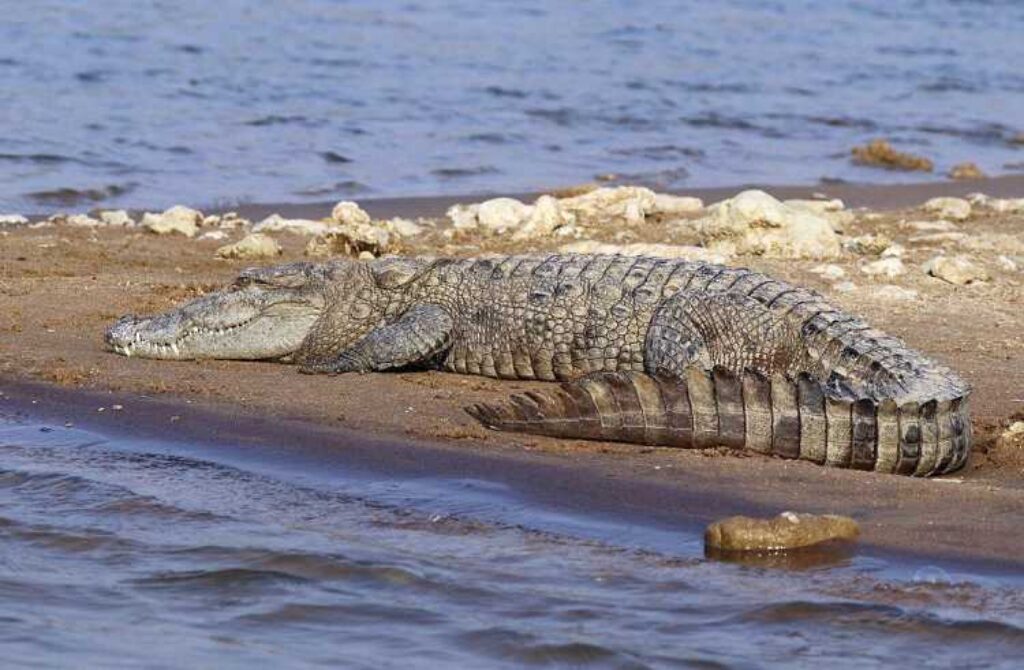
Mugger crocodiles are one of the largest freshwater crocodile species, and they have unique physical characteristics that distinguish them from other crocodile species. In this section, we will discuss the physical characteristics and behavior of mugger crocodiles in detail.
Broad Snout for Crushing Prey
Unlike other crocodile species that have narrow snouts used for catching fish, mugger crocodiles have a broad snout adapted for crushing prey.
This adaptation allows them to feed on a variety of prey, including fish, birds, mammals, and reptiles. Their powerful jaws can exert immense pressure when biting down on their prey, making it difficult for their victims to escape.
Webbed Feet for Excellent Swimming Ability
Mugger crocodiles have webbed feet that make them excellent swimmers. Their feet allow them to move through water with ease and speed. They can swim up to 30 km/hour (18 mph) when chasing prey or escaping danger.
Large Size
Mugger crocodiles can grow up to 4 meters (13 feet) in length and mature individuals can weigh up to 400 kg (880 pounds). Their size makes them one of the largest freshwater crocodile species in the world. However, their size varies depending on their habitat and food availability.
Keeled Scales for Protection and Temperature Regulation
Mugger crocodiles have keeled scales on their body that provide protection against predators and help regulate their body temperature. The keeled scales are raised ridges along the length of each scale that give it a rough texture. These scales also help mugger crocodiles blend into their environment by breaking up their outline.
Dark Olive Outer Toes
The outer toes of mugger crocodiles are dark olive in color which helps them blend in with their environment. This adaptation is essential as it helps them avoid detection by their prey and predators.
Behavior
Mugger crocodiles are primarily solitary animals, but they can be found in groups during the breeding season.
They are territorial and will defend their territory against other mugger crocodiles. During the breeding season, males will compete for females by displaying aggressive behavior such as head slapping, tail thrashing, and vocalization.
Mugger crocodiles are opportunistic feeders and will eat a variety of prey depending on availability. Their diet includes fish, birds, mammals, reptiles, and even carrion. They hunt by ambushing their prey from the water or land.
Mugger crocodiles have a unique way of communicating with each other through vocalizations. They produce a range of sounds including hisses, growls, grunts, and bellows to communicate with other mugger crocodiles.
Are you curious about the lifespan of crocodiles? Our latest article has all the answers! Check it out to learn about the factors that affect their longevity and how long these fascinating creatures can live.
Habitat and Distribution of Mugger Crocodiles

Mugger crocodiles are one of the largest freshwater crocodile species found in the Indian subcontinent.
Their range extends from Iran to the Indian peninsula, where they occupy a unique ecological niche in their place of origin.
These crocodiles prefer freshwater habitats such as rivers, marshes, and freshwater lakes, but can also be found in irrigation canals and other man-made bodies of water.
Habitat destruction due to human activities has led to a decline in the crocodile population, and they are currently listed as vulnerable on the IUCN Red List.
The loss of habitat is mainly due to deforestation, dam construction, and agricultural expansion. As a result, many muggers have lost their natural habitats and have been forced to move into urban areas.
Mugger crocodiles are often found sharing their habitat with other crocodile species such as saltwater crocodiles. However, they have adapted well to occupy a unique ecological niche in their place of origin. They are known for their ability to survive in harsh environments where other species cannot thrive.
The preferred habitat for mugger crocodiles is slow-moving or still water bodies with dense vegetation cover along the banks. These conditions provide ample opportunities for basking and nesting sites for females during breeding season. Rivers that have sandy banks or mud flats provide ideal nesting sites for female muggers.
Mugger crocodiles are also known as Crocodylus palustris which means “marsh-dwelling”. This name accurately describes their preferred habitat which includes marshes and swamps. Marshes provide an abundance of food sources including fish, crustaceans, mollusks, amphibians and reptiles.
Freshwater lakes are another preferred habitat for mugger crocodiles because they offer ample food sources. Lakes that have dense vegetation cover around them provide perfect hiding spots for these reptiles when hunting prey.
Irrigation canals are also a popular habitat for mugger crocodiles. These canals provide an abundance of food sources and are often used by farmers to irrigate their crops. However, these canals can be dangerous for humans who come into contact with the crocodiles.
Mugger crocodiles have adapted well to living in man-made habitats such as reservoirs and ponds. These habitats offer ample opportunities for basking and nesting sites for females during breeding season.
The saltwater crocodile is another species that shares the habitat with mugger crocodiles. Saltwater crocodiles are known to be more aggressive than muggers, but they do not compete for resources because they occupy different ecological niches.
What is the difference between a saltwater crocodile and a mugger crocodile?
Saltwater crocodiles (Crocodylus porosus) are the largest living reptiles in the world and are found in the coastal habitats of Southeast Asia and Northern Australia, whereas mugger crocodiles (Crocodylus palustris) are found mainly in freshwater habitats across the Indian subcontinent.
In terms of physical appearance, saltwater crocodiles have a longer snout, a narrower head, and a lighter coloration compared to the darker and stockier mugger crocodile.
Saltwater crocodiles can also grow to be larger in size, with some individuals reaching up to 7 meters (23 feet) in length, while mugger crocodiles typically range from 3 to 4 meters (10 to 13 feet) in length.
In terms of behavior, both species are known to be aggressive and opportunistic predators, but saltwater crocodiles are generally considered more dangerous to humans due to their larger size, more powerful jaws, and tendency to inhabit coastal areas where human interactions are more common.
Breeding, Feeding, and Range of Mugger Crocodiles
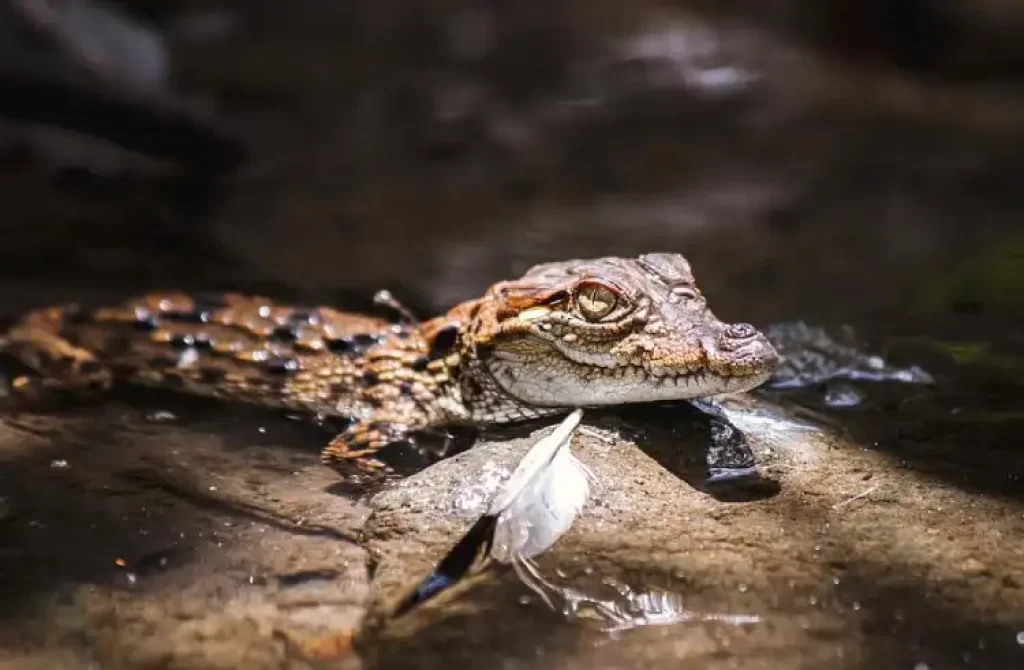
Mugger crocodiles are one of the most fascinating species of crocodile. They are known for their broadest snout among all crocodile species, which makes them efficient predators of fish and other aquatic animals. In this section, we will discuss the breeding, feeding, and range of mugger crocodiles.
Breeding and Reproduction
Breeding and reproduction of mugger crocodiles usually occur during the dry season when water levels are low.
Courtship involves vocalizations and physical displays by males to attract females. The male mugger crocodile approaches a female with his head held high in the air while making a deep bellowing sound. He then lowers his head to the ground while opening his jaws wide to show off his teeth.
If the female is interested in mating, she will respond by making a series of grunting noises while positioning herself close to the male. After mating occurs, female mugger crocodiles lay clutches of up to 40 eggs in nests made of vegetation. They guard the nests until the hatchlings emerge after about 2-3 months.
Hatchlings
Mugger crocodile hatchlings are vulnerable to predation by other species, including birds and larger crocodiles. They feed on small animals such as insects, crustaceans, and fish. Hatchlings have yellowish-brown skin with black stripes that fade as they grow older.
Feeding Habits
Mugger crocodiles are opportunistic predators that feed on a variety of prey items such as fish, birds, mammals, reptiles, amphibians, crustaceans, and insects. They use their powerful jaws to capture prey items before dragging them underwater where they drown them.
Range
The mugger crocodile is found in southern Iran through Pakistan into India (where it is also called marsh or swamp crocodile), Nepal and Bhutan. They are also found in Sri Lanka, Bangladesh, and Myanmar.
Threats
In the wild, mugger crocodiles face threats from habitat loss, hunting for their skin and meat, accidental entanglement in fishing nets, and capture for captivity or animal trade. The International Union for Conservation of Nature (IUCN) lists the mugger crocodile as vulnerable due to these threats.
Habits and Lifestyle of Mugger Crocodiles in the Wild

Mugger crocodiles, also known as snouted crocodiles or simply muggers, are fascinating creatures that inhabit shallow water bodies across the Indian subcontinent.
These reptiles are opportunistic predators that chase prey both in water and on land, and their diet includes fish, crustaceans, small mammals, and birds.
Female muggers dig burrows in the banks of rivers or lakes to lay their eggs, which they guard fiercely until hatching.
The hatchlings are about 30 cm long and have distinctive black spots on their pale olive skin. As they grow older, the black spots fade away and the skin becomes darker.
Adult mugger crocodiles can reach up to 4 meters in length and weigh over 200 kg. They have powerful jaws with sharp teeth that can crush bones and tear flesh.
Despite their fearsome reputation as man-eaters, attacks on humans are rare unless provoked or disturbed.
During dry seasons when water levels recede, muggers may become more aggressive and attacks on humans or livestock can occur.
This is because they are forced to compete for limited resources such as food and water. Therefore, conservation efforts to protect both humans and crocodiles are crucial for the survival of these magnificent creatures.
In terms of lifestyle habits, mugger crocodiles are mostly active during the day but can also be active at night if there is enough light available.
They spend most of their time basking in the sun to regulate their body temperature since they are cold-blooded animals.
Muggers communicate with each other through a variety of vocalizations such as hisses, grunts, roars, and bellows. They also use visual displays such as head movements and tail slaps to signal aggression or submission.
Female muggers lay around 20-40 eggs per clutch depending on their size. The eggs take around 2-3 months to hatch, and the hatchlings are completely independent from birth. However, they may stay close to their mother for protection and guidance.
In terms of social behavior, mugger crocodiles are mostly solitary animals but can also be found in small groups during mating season or when resources are abundant. They establish territories and defend them fiercely against intruders.
Economic Importance of Mugger Crocodiles for Humans
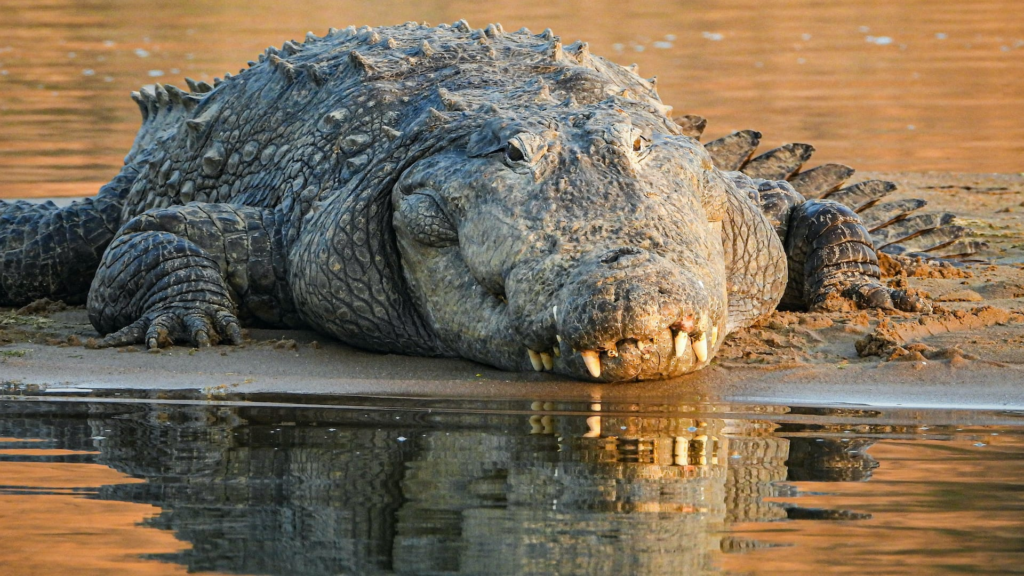
Mugger crocodiles are not only fascinating creatures but also have economic importance for humans. In this section, we will discuss how mugger crocodiles contribute to the economy and provide a source of income for local communities.
Ecotourism
One of the significant contributions of mugger crocodiles to the economy is through ecotourism. These reptiles attract visitors to areas where they are found, generating revenue for local communities. Tourists come from far and wide to see these magnificent creatures in their natural habitats.
The presence of mugger crocodiles in an area can create jobs for locals who work as tour guides or run small businesses such as restaurants and souvenir shops.
Ecotourism can also raise awareness about conservation efforts, which can help protect these animals from habitat destruction and poaching.
Leather Industry
The skin of mugger crocodiles is used to make leather products such as shoes, belts, and bags. The leather industry provides a source of income for people involved in the production process, including hunters who capture the animals, tanners who process the skins, and manufacturers who produce finished goods.
Mugger crocodile leather is highly valued due to its durability and unique texture. It is often used by luxury brands that cater to high-end customers.
Fish Population Control
Mugger crocodiles play a vital role in controlling fish populations in their habitats. They prey on fish species that may otherwise overpopulate and cause imbalances in aquatic ecosystems. By keeping fish populations under control, mugger crocodiles benefit human fishing activities by preventing overfishing and maintaining healthy fish stocks.
Conservation Efforts
Despite their economic importance, mugger crocodile populations face threats from habitat loss due to human activities such as dam construction or agriculture expansion. Poaching is another significant threat since their skin is highly valued in the leather industry.
Conservation efforts are essential to ensure the survival of mugger crocodiles and their contribution to the economy. Several organizations work towards protecting these animals by creating protected areas, monitoring populations, and raising awareness about conservation issues.
Behavior and Ecology of Mugger Crocodiles
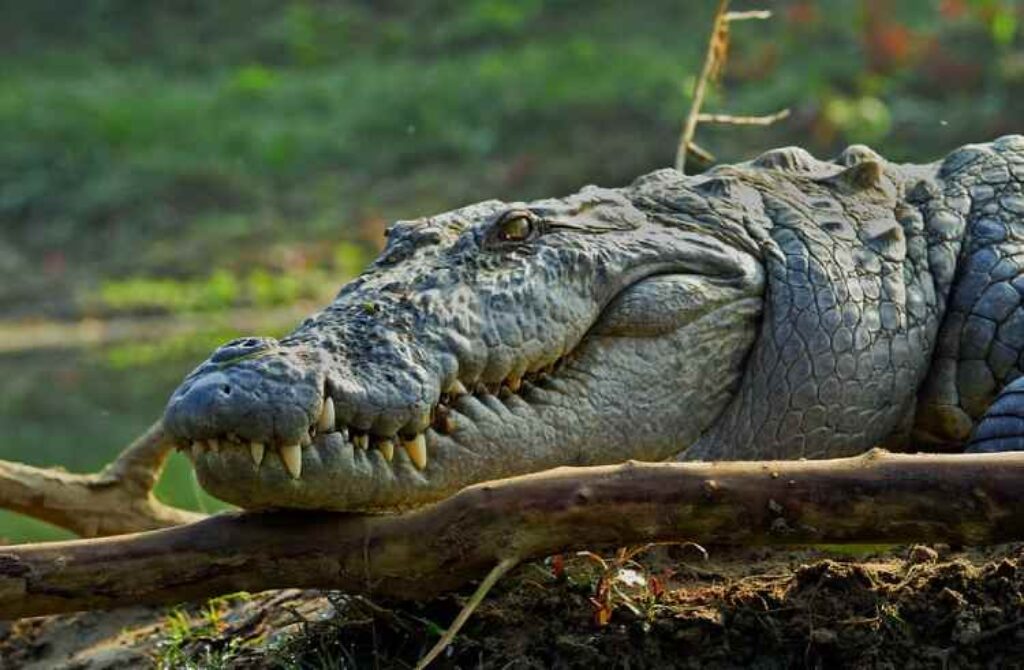
Mugger crocodiles are fascinating creatures that have been studied extensively for their behavior and ecology. These crocodiles are known for their aggressive behavior towards humans and other animals, especially during the breeding season.
Mugger crocodiles are ambush predators that use their excellent camouflage to hide in the water or on the banks of rivers and lakes to catch their prey.
One of the most interesting aspects of mugger crocodile behavior is their unique vocalizations. During mating season and territorial disputes, these crocodiles use a variety of sounds to communicate with each other.
These vocalizations range from deep grunts to high-pitched hisses, depending on the situation.
Mugger crocodiles also exhibit interesting social behavior. They tend to be more solitary than other species of crocodile, but they do form small groups during mating season or when basking in the sun. These groups can consist of up to 10 individuals, although they typically only last for a short period of time.
In terms of ecology, mugger crocodiles play an important role in maintaining the balance of aquatic ecosystems by controlling the populations of fish and other aquatic animals.
They are apex predators that help keep smaller species in check, which ultimately benefits the entire ecosystem.
Despite their importance in maintaining ecological balance, mugger crocodiles have faced significant threats from human activities such as habitat destruction and hunting for their skin and meat.
Conservation efforts have helped stabilize populations in some areas, but more work needs to be done to ensure these magnificent creatures continue to thrive.
You might also like: If you’re interested in learning more about crocodilians, we have a comprehensive article dedicated to the fascinating Cuban crocodile that you might enjoy reading. You can find it here.
Diet and Nutrition of Mugger Crocodiles
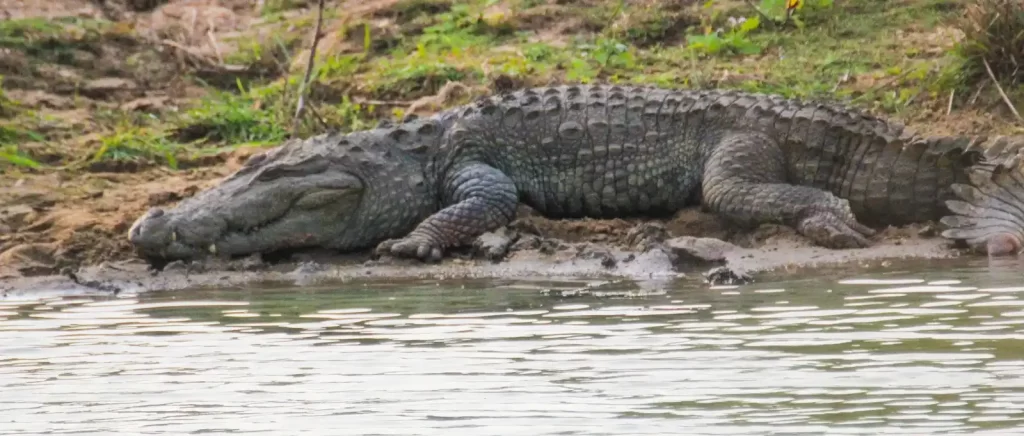
Mugger crocodiles are known to be opportunistic feeders, which means that they will eat whatever prey is available to them. Their diet consists of fish, birds, mammals, and occasionally other reptiles. Juvenile mugger crocodiles primarily feed on insects and small fish before transitioning to larger prey as they grow.
Fish make up a significant portion of the mugger crocodile’s diet. They are known to consume a variety of fish species including catfish, tilapia, and carp. Mugger crocodiles have been observed using their powerful jaws and sharp teeth to catch fish in shallow water or near the surface of the water.
In addition to fish, mugger crocodiles also consume birds such as ducks and wading birds. They are known to ambush their prey by hiding in vegetation or under the water before lunging out to grab their target with lightning-fast reflexes.
Mammals are another important part of the mugger crocodile’s diet. They have been observed consuming animals such as deer, wild boar, and monkeys. Mugger crocodiles use their powerful jaws and sharp teeth to kill their prey before dragging it into deeper water where they can more easily consume it.

Occasionally, mugger crocodiles will also consume other reptiles such as snakes or smaller species of turtles. This is particularly true for juvenile mugger crocodiles who may not yet be large enough to take down larger prey.
One interesting aspect of the mugger crocodile’s diet is its ability to extract nutrients from tough and fibrous prey such as turtles and crabs. These types of prey can be difficult for many predators to digest due to their hard shells or tough exoskeletons. However, the mugger crocodile has a powerful digestive system that allows it to break down these tough materials and extract valuable nutrients from them.
Fun Facts for Kids: 10 Interesting Mugger Crocodile Facts
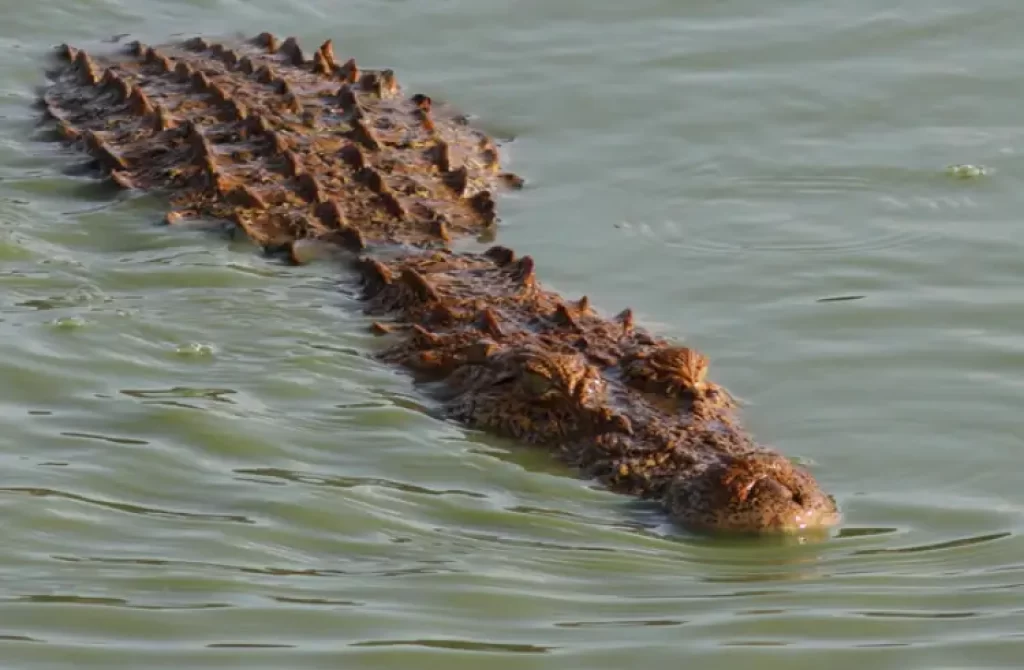
Mugger crocodiles are fascinating creatures that have been around for millions of years. These reptiles are known for their incredible strength, unique communication skills, and adaptability to various environments. In this section, we will explore 10 interesting facts about mugger crocodiles that kids will love.
1. Mugger Crocodiles Have A Wide Range
Mugger crocodiles can be found in a variety of habitats across the Indian subcontinent and parts of Southeast Asia. They can be found in freshwater rivers, lakes, and marshes as well as brackish water estuaries and mangrove swamps.
2. Mugger Crocodiles Are One Of The Few Species That Can Tolerate Both Saltwater And Freshwater Environments
Unlike most crocodile species that prefer freshwater or saltwater environments, mugger crocodiles can tolerate both. This ability allows them to thrive in a wide range of habitats and makes them one of the most adaptable crocodile species.
3. Mugger Crocodiles Have A Unique Way Of Communicating With Each Other
Mugger crocodiles communicate with each other through vocalizations such as grunts, hisses, and bellows. These sounds help them establish territories and attract mates during breeding season.
4. Mugger Crocodiles Can Hold Their Breath For Up To An Hour
Mugger crocodiles have a special adaptation that allows them to hold their breath for an extended period underwater while waiting for prey to pass by.
5. Mugger Crocodile Eggs Change Gender Based On Temperature
The gender of mugger crocodile hatchlings is determined by the temperature at which the eggs are incubated. Warmer temperatures produce more males while cooler temperatures produce more females.
6. Mugger Crocodile Hatchlings Are Vulnerable To Predators
Mugger crocodile hatchlings are vulnerable to predators such as birds, fish, and other reptiles. Only a small percentage of hatchlings survive to adulthood.
7. Mugger Crocodiles Have A Powerful Bite Force
Mugger crocodiles have one of the strongest bite forces among crocodile species. Their jaws can crush bones and tear apart prey, making them one of the top predators in their habitat.
8. Mugger Crocodiles Are Opportunistic Feeders
Mugger crocodiles are opportunistic feeders and will eat almost anything they can catch, including fish, birds, mammals, and other reptiles.
9. Mugger Crocodile Mothers Protect Their Young
Female mugger crocodiles are fiercely protective of their young and will aggressively defend them against predators or any perceived threats.
10. Mugger Crocodiles Play An Important Role In The Ecosystem
As top predators in their habitats, mugger crocodiles play an important role in regulating populations of other animals such as fish and water birds. They also help maintain healthy aquatic ecosystems by controlling the population sizes of prey species.
Taxonomy and Evolution of Mugger Crocodiles
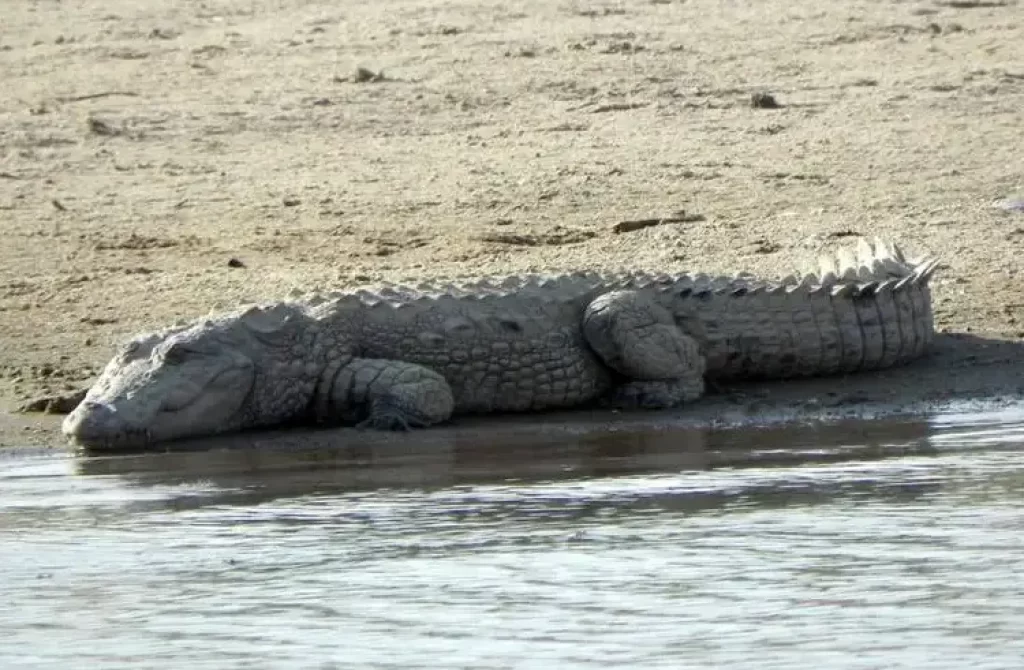
Mugger crocodiles belong to the family Crocodylidae, which is one of the three families of crocodilians. The scientific name for mugger crocodile is Crocodylus palustris. The genus Crocodylus contains 14 species, including the American crocodile, the saltwater crocodile, and the Nile crocodile.
The mugger crocodile is a medium-sized species that can grow up to 4 meters long. They have a broad snout and thick scales on their back that help protect them from predators.
Mugger crocodiles are found in freshwater habitats such as rivers, lakes, and marshes in India, Pakistan, Sri Lanka, Nepal, and Bangladesh.
Mugger crocodiles are believed to have diverged from other members of the genus Crocodylus around 8 million years ago during the Miocene epoch. Fossil evidence suggests that they once had a much wider distribution across Asia but have since become restricted to their current range due to habitat loss and hunting.
Despite being classified as reptiles, mugger crocodiles share many characteristics with mammals. For example, they have four-chambered hearts like mammals do instead of three-chambered hearts like most reptiles. This allows them to maintain a higher metabolism and be more active than other reptile species.
In terms of behavior and ecology, mugger crocodiles are opportunistic predators that feed on fish, birds, small mammals, and even other reptiles.
They are also known for their ability to hunt cooperatively by herding prey towards each other or using vocalizations to communicate with one another while hunting.
Mugger crocodiles play an important role in their ecosystems by controlling populations of prey species and helping maintain healthy aquatic habitats through their burrowing activities. However, they are also hunted for their meat and skin, which has led to declines in their populations in some areas.
Mugger Crocodiles FAQ’s
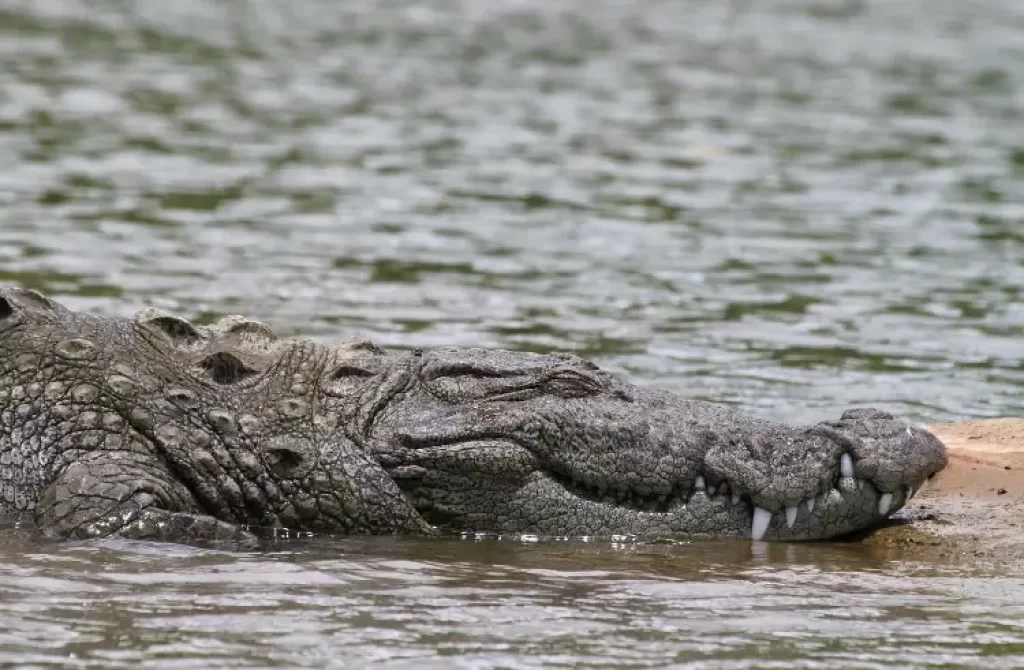
Are mugger crocodiles harmless?
No, mugger crocodiles are not harmless. While they are not as aggressive as some other species of crocodiles, they are still considered to be dangerous and have been known to attack humans.
In areas where they come into contact with people, they can pose a serious threat, especially if they are provoked or feel threatened. It is important to always exercise caution and follow safety guidelines when in areas where crocodiles are present.
How aggressive are mugger crocodiles?
Mugger crocodiles (Crocodylus palustris) can be aggressive towards humans if they feel threatened or provoked, especially during the breeding season when males can become territorial.
They have been known to attack and kill humans who venture too close to their habitat, particularly in rural areas where people rely on water bodies for their daily activities.
It is important to exercise caution and avoid contact with mugger crocodiles in their natural habitat to prevent any potential harm.
What is a mugger crocodile give two characteristics?
A mugger crocodile (Crocodylus palustris) is a medium-sized crocodilian species native to the Indian subcontinent and Iran. Here are two of its characteristics:
- Strong Jaw: Mugger crocodiles have a powerful jaw that allows them to crush and devour their prey. They have an average bite force of 1,000 PSI, which is strong enough to break the bones of their prey.
- Semi-aquatic: Mugger crocodiles are semi-aquatic, which means they spend a significant amount of time both on land and in the water. They are excellent swimmers and can move quickly through water, but are also capable of moving quickly on land.
Related pages:
- Crocodiles in Florida
- How Fast Can a Crocodile Swim?
- Eastern Ribbon Snakes (Thamnophis sauritus)
- Morelet’s Crocodile (Crocodylus moreletii)
References:
- RoundGlass Sustain. (n.d.). Mugger. Retrieved from https://roundglasssustain.com/species/mugger
- Crocodile Specialist Group. (2015). Crocodylus palustris. The IUCN Red List of Threatened Species 2015: e.T5669A3048311. https://dx.doi.org/10.2305/IUCN.UK.2015-4.RLTS.T5669A3048311.en
- Mukherjee, S., Ray, A., Purkayastha, J., Kundu, N., & Bhattacharjee, P. (2022). Distribution, ecology and conservation of the mugger crocodile, Crocodylus palustris in India: A review. Journal of Asia-Pacific Biodiversity, 15(3), 413-422. https://doi.org/10.1016/j.japb.2022.02.004
- Vyas, R., & Vasava, A. (2019). Spatial distribution and habitat suitability modelling of mugger crocodile, Crocodylus palustris (Reptilia: Crocodylidae) in South Gujarat landscape, India. Herpetological Conservation and Biology, 14(3), 562-573.
- Mahajan, A., & Sharma, P. (2019). Conservation awareness and economic valuation of mugger (Crocodylus palustris) in selected villages of Chambal River Basin, India. Journal of Ornithology and Wildlife Biology, 1(1), 14-22.
- Mugger Wikipedia article – https://en.wikipedia.org/wiki/Mugger_crocodile
- 2. Mugger on The IUCN Red List site – http://www.iucnredlist.org/details/5667/0







